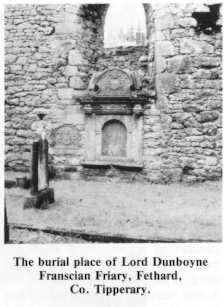|
| |

John Butler, Bishop of Cork, Lord Dunboyne
was born, it is reckoned, in 1731. He was the third son of the 18th Lord
Dunboyne of Grange, Co. Tipperary. (At that time, the ancestral lands
and castle at Dunboyne were not in the family possession; their recovery
became the subject of court cases in later years). it could not have been
foreseen, at the time of his birth, that he would in later life, become
the subject of a scandal that would rock the Catholic Church.
John Butler's father died in 1732 and
his eldest brother succeeded to the title. With three other sons in the
family, it must have seemed that the Dunboyne title was relatively secure.
There could have been few succession worries when John decided to become
a priest at the age of nineteen. He was ordained in Rome in 1755. An examination
prior to ordination, noted that his left eye was missing (which at that
time could have been an obstacle to taking Holy Orders). Although the
cause is not certain, it was later believed perhaps unfairly - that the
loss of his eye occurred in a brawl or duel.
Father Butler returned to Ireland soon
after ordination and about a year later was appointed Parish Priest of
Ardmayle in Co. Tipperary. This parish belonged to the Diocese of Cashel,
which was administered by Archbishop James Butler, a relation of the new
parish priest. Some years later, when the See of Cork became vacant, Fr.
John Butler, was appointed Bishop of Cork. The representations of Archbishop
Butler and other influential friends provided support in the case made
for his appointment. He was only in his early thirties at the time of
his consecration as Bishop in 1763. He remained Bishop of Cork for 23
years.
During John Butler's years as Bishop
of Cork, his family suffered the loss of four successors to the Dunboyne
title. His eldest brother, the 19th Lord Dunboyne, died in 1768, unmarried
and without an heir. His brother Pierce then succeeded to the title. Pierce
turned Protestant in 1769, which must have been at least an embarrassment
to his brother, the Catholic Bishop. When Pierce died in 1773 and the
youngest brother Edmond died in 1781, the Dunboyne title was due to pass
to Pierce's son (also Pierce), who was a delicate child. The young heir
died in January 1786.
As a result, John Butler, Bishop of
Cork, being the last male successor became the 22nd Lord Dunboyne. This
inheritance posed grave problems for the Bishop. Vowed to celibacy by
his priesthood, he was faced with the certainty, that as the last of his
line the ancient Dunboyne title-it had existed from the 12th century-would
on his death, pass from his branch of the Butler family. This dilemma
must have caused the Bishop much anguish. He finally made the decision
to resign the Bishopric of Cork and seek the Pope's dispensation.
By December 1786, he had written to the
Pope, resigning as Bishop of Cork. He had also contracted to marry a young
relation, Maria Butler, in the hope of producing an heir. While deeply
disappointed by the Pope's refusal of a dispensation, John Butler went
ahead with his plans to marry. The marriage took place before the end
of April 1787. His defection was published in newspapers of the time.
His subsequent recantation and adoption
of the Established religion was a matter of deep concern to hierarchy
and laity alike and a topic of widespread discussion. There was even a
broadsheet ballad quickly for sale on the subject of the Bishop.
John Butler's hopes of fathering an heir
proved vain. While it seems that his wife gave birth to a baby daughter
who did not survive, there are no records. For a time after their marriage
Lord and Lady Dunboyne lived in Dunboyne Castle. The castle and estates
had been recovered *in law suits prior to John Butler's inheritance of
the title. They spent summers in Gracefield - a house in Balbriggan. After
some years, they moved to a rented house at No. 18 Leeson Street. Lord
Dunboyne died in the Leeson Street house on May 7th 1800. In the days
prior to his death, he wrote to the Archbishop of Dublin and to the Pope,
seeking reconciliation with the Church. The Archbishop asked Fr. William
The burial place of Lord Dunboyne Franscian Friary, Fethard, Co. Tipperary.
Gahan, a noted Augustinian, to visit Lord Dunboyne. It is believed that
Fr. Gahan absolved the dying man.
John Butler's death and reported deathbed
re-conversion to the Catholic faith gave rise to almost as much controversy
as his defection. The terms of his Lordship's will stipulated that, after
the death of his sister, Mrs. O'Brien Butler, the Castle and other properties
in the County of Meath should be bequeathed to the Trustees, of St. Patrick's
College, Maynooth, for the benefit and use of the College. This bequest
angered Mrs. O'Brien Butler, who challenged the will in court. A settlement
was reached between the parties and given legal effect by the enactment
of a special Act of Parliament in 1808. This enabled the College to fund
the Dunboyne Establishment in Maynooth. This Establishment was to maintain
selected students for additional studies. The student's chosen were to
be exemplary in their scholarship and morals. To achieve the purpose of
the Establishment a special building called Dunboyne House was erected
in 1813.
It is curious to think that the scandal
caused by John Butler's resignation, marriage and his adoption of Protestantism
was countered to some degree by his bequest to Maynooth. Those who benefited
from the Dunboyne Establishment would labour on behalf of the Church,
which had been so rocked by its benefactor - a strange reversal.
|